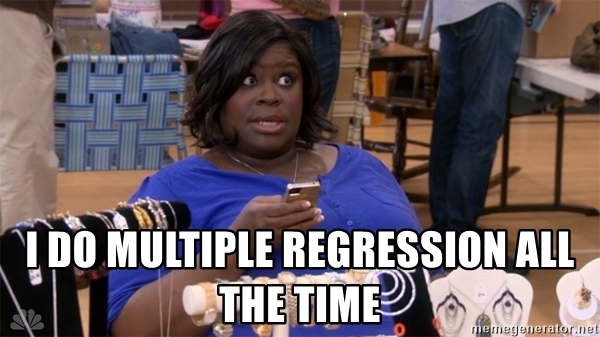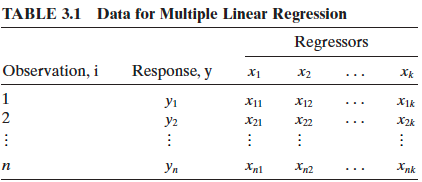Multiple Linear Regression 👨💻
MATH 4780 / MSSC 5780 Regression Analysis
Department of Mathematical and Statistical Sciences
Marquette University
Multiple Linear Regression Model (MLR)
Why Multiple Regression?
- Our target response may be affected by several factors.
- Total sales \((Y)\) and amount of money spent on advertising on YouTube (YT) \((X_1)\), Facebook (FB) \((X_2)\), Instagram (IG) \((X_3)\).


- Predict sales based on the three advertising expenditures and see which medium is more effective.
Fit Separate Simple Linear Regression Models
Fit three separate independent SLR models:

❌ Fitting a separate SLR model for each predictor is not satisfactory.
Don’t Fit a Separate Simple Linear Regression
- 👉 How to make a single prediction of sales given levels of the 3 advertising media budgets?
- How to predict the sales when the amount spent on YT is 50, 100 on FB and 30 on IG?
- 👉 Each regression equation ignores the other 2 media in forming coefficient estimates.
- The effect of FB advertising on sales may be increased or decreased when YT and IG advertising are in the model.
- IG advertising may have no impact on sales when YT and FB advertising are in the model.
- 👍👍 Better approach: extend the SLR model so that it can directly accommodate multiple predictors.
I hope you don’t feel…

What I hope is…

Multiple Linear Regression (MLR) Model
- We have \(k\) distinct predictors. The (population) multiple linear regression model: \[Y_i= \beta_0 + \beta_1X_{i1} + \beta_2X_{i2} + \dots + \beta_kX_{ik} + \epsilon_i\]
- \(X_{ij}\): \(j\)-th regressor value on \(i\)-th measurement, \(j = 1, \dots, k\).
- \(\beta_j\): \(j\)-th coefficient quantifying the association between \(X_j\) and \(Y\).
- In the advertising example, \(k = 3\) and \[\texttt{sales} = \beta_0 + \beta_1 \times \texttt{YouTube} + \beta_2 \times \texttt{Facebook} + \beta_3 \times \texttt{Instagram} + \epsilon\]
- Assumptions as SLR
- \(\epsilon_i \stackrel{iid}{\sim} N(0, \sigma^2)\)
- When \(k = 1\), MLR is reduced to SLR.
How many parameters are there in the model?
Sample MLR Model
- Given the training sample data \((x_{11}, \dots, x_{1k}, y_1), (x_{21}, \dots, x_{2k}, y_2), \dots, (x_{n1}, \dots, x_{nk}, y_n),\)
- The sample MLR model: \[\begin{align} y_i &= \beta_0 + \beta_1x_{i1} + \beta_2x_{i2} + \dots + \beta_k x_{ik} + \epsilon_i \\ &= \beta_0 + \sum_{j=1}^k\beta_j x_{ij} + \epsilon_i, \quad i = 1, 2, \dots, n \end{align}\]

Regression Hyperplane
- SLR: regression line
- MLR: regression hyperplane or response surface
- \(y = \beta_0 + \beta_1x_1 + \beta_{2}x_2 + \epsilon\)
- \(E(y \mid x_1, x_2) = 50 + 10x_1 + 7x_2\)


Response Surface : Interaction Model
- \(y = \beta_0 + \beta_1x_1 + \beta_{2}x_2 + \beta_{12}x_1x_2 + \epsilon\)
- This is in fact a linear regression model: let \(\beta_3 = \beta_{12}, x_3 = x_1x_2\).
- \(E(y \mid x_1, x_2) = 50 + 10x_1 + 7x_2 + 5x_1x_2\)
- 😎 🤓 A linear model generates a nonlinear response surface!


Response Surface : 2nd Order with Interaction Model
- \(y = \beta_0 + \beta_1x_1 + \beta_{2}x_2 + \beta_{11}x_1^2 + \beta_{22}x_2^2 + \beta_{12}x_1x_2 + \epsilon\)
- \(E(y) = 800+10x_1+7x_2 -8.5x_1^2-5x_2^2- 4x_1x_2\)
- 😎 🤓 A linear regression model can describe a complex nonlinear relationship between the response and predictors!


Point Estimation of Model Parameters
Least Square Estimation of the Coefficients
\[\begin{align} y_i &= \beta_0 + \beta_1x_{i1} + \beta_2x_{i2} + \dots + \beta_k x_{ik} + \epsilon_i \\ &= \beta_0 + \sum_{j=1}^k\beta_j x_{ij} + \epsilon_i, \quad i = 1, 2, \dots, n \end{align}\]
- The least-squares function is \[S(\alpha_0, \alpha_1, \dots, \alpha_k) = \sum_{i=1}^n\left(y_i - \alpha_0 - \sum_{j=1}^k\alpha_j x_{ij}\right)^2\] The function \(S(\cdot)\) must be minimized with respect to the coefficients, i.e., \[(b_0, b_1, \dots, b_k) = \underset{{\alpha_0, \alpha_1, \dots, \alpha_k}}{\mathrm{arg \, min}} S(\alpha_0, \alpha_1, \dots, \alpha_k)\]
Geometry of Least Square Estimation

Least-squares Normal Equations
\[\begin{align} \left.\frac{\partial S}{\partial\alpha_0}\right\vert_{b_0, b_1, \dots, b_k} &= -2 \sum_{i=1}^n\left(y_i - b_0 - \sum_{j=1}^k b_j x_{ij}\right) = 0\\ \left.\frac{\partial S}{\partial\alpha_j}\right\vert_{b_0, b_1, \dots, b_k} &= -2 \sum_{i=1}^n\left(y_i - b_0 - \sum_{j=1}^k b_j x_{ij}\right)x_{ij} = 0, \quad j = 1, 2, \dots, k \end{align}\]
- \(p = k + 1\) equations with \(p\) unknown parameters.
- The ordinary least squares estimators are the solutions to the normal equations.
🍹 🍺 🍸 🥂 I buy you a drink if you solve the equations for \(k \ge 2\) by hand without using matrix notations or operations!
R Lab Delivery Time Data
# Load the data set
delivery <- read.csv(file = "./data/data-ex-3-1.csv",
header = TRUE)
delivery_data <- delivery[, -1]
colnames(delivery_data) <- c("time", "cases", "distance")
str(delivery_data)'data.frame': 25 obs. of 3 variables:
$ time : num 16.7 11.5 12 14.9 13.8 ...
$ cases : int 7 3 3 4 6 7 2 7 30 5 ...
$ distance: int 560 220 340 80 150 330 110 210 1460 605 ...- \(y\): the amount of time required by the route driver to stock the vending machines with beverages
- \(x_1\): the number of cases stocked
- \(x_2\): the distance walked by the driver
delivery_data time cases distance
1 16.7 7 560
2 11.5 3 220
3 12.0 3 340
4 14.9 4 80
5 13.8 6 150
6 18.1 7 330
7 8.0 2 110
8 17.8 7 210
9 79.2 30 1460
10 21.5 5 605
11 40.3 16 688
12 21.0 10 215
13 13.5 4 255
14 19.8 6 462
15 24.0 9 448
16 29.0 10 776
17 15.3 6 200
18 19.0 7 132
19 9.5 3 36
20 35.1 17 770
21 17.9 10 140
22 52.3 26 810
23 18.8 9 450
24 19.8 8 635
25 10.8 4 150R Lab Scatterplot Matrix
pairs(delivery_data)
R Lab 3D Scatterplot
Code
par(mgp = c(2, 0.8, 0), las = 1, mar = c(4, 4, 0, 0))
library(scatterplot3d)
scatterplot3d(x = delivery_data$cases, y = delivery_data$distance, z = delivery_data$time,
xlab ="cases", ylab = "distance", zlab = "time",
xlim = c(2, 30), ylim = c(36, 1640), zlim = c(8, 80),
box = TRUE, color = "blue", mar = c(3, 3, 0, 2), angle = 30, pch = 16)
R Lab Multiple Linear Regression
delivery_lm <- lm(time ~ cases + distance, data = delivery_data)
delivery_lm$coef(Intercept) cases distance
2.341 1.616 0.014 \[\hat{y} = 2.34 + 1.62x_1 + 0.014x_2\]
\(b_1\): All else held constant, for one case of product stocked increase, we expect the delivery time to be longer, on average, by 1.62 minutes.
\(b_2\): All else held constant, one additional foot walked by the driver causes the delivery time, on average, to be 0.014 minutes longer.
\(b_0\): The delivery time with no number of cases of product stocked and no distance walked by the driver is expected to be 2.34 minutes. (Make sense?!)
R Lab Regression Plane

Estimation of \(\sigma^2\)
\(SS_{res} = \sum_{i=1}^ne_i^2 = \sum_{i=1}^n(y_i - \hat{y}_i)^2\).
\(MS_{res} = \frac{SS_{res}}{n - p}\) with \(p = k + 1\).
\(S^2 = MS_{res}\) is unbiased for \(\sigma^2\), i.e., \(E[MS_{res}] = \sigma^2\).
\(S^2\) of SLR may be quite larger than the \(S^2\) of MLR.
\(S^2\) measures the variation of the unexplained noise about the fitted regression line/hyperplane, so we prefer a small residual mean square.
R Lab Estimation of \(\sigma^2\)
## method 1
summ_delivery <- summary(delivery_lm) ## check names(summ_delivery)
summ_delivery$sigma ^ 2[1] 11## method 3
(SS_res1 <- sum((delivery_data$time - delivery_lm$fitted.values) ^ 2))[1] 234SS_res1 / (n - 3)[1] 11Confidence Interval
CI for Coefficients
CI for the Mean Response
PI for New Observations
Properties of LSEs
- 👍 \({\bf b} = (b_0, b_1, \dots, b_k)'\) is BLUE.
- Linear : Each \(b_j\) is a linear combination of \(y_1, \dots, y_n\).
- Unbiased : Each \(b_j\) is normally distributed with mean \(\beta_j\).
- Best : Each \(b_j\) has the minimum variance, comparing to all other unbiased estimator for \(\beta_j\) that is a linear combo of \(y_1, \dots, y_n\).
Wald CI for Coefficients
The \((1-\alpha)100\%\) Wald CI for \(\beta_j\), \(j = 0, 1, \dots, k\) is \[\left(b_j- t_{\alpha/2, n-p}~se(b_j), \quad b_j + t_{\alpha/2, n-p}~ se(b_j)\right)\]
(ci <- confint(delivery_lm)) 2.5 % 97.5 %
(Intercept) 0.0668 4.616
cases 1.2618 1.970
distance 0.0069 0.022- These are marginal CIs seperately for each \(b_j\).
Correlated Coefficients
## correlation matrix
cov2cor(V) (Intercept) cases distance
(Intercept) 1.00 -0.25 -0.22
cases -0.25 1.00 -0.82
distance -0.22 -0.82 1.00\(b_1\) and \(b_2\) are negatively correlated.
Individual CI ignores the correlation between \(b_j\)s.
How do we specify a confidence level that applies simultaneously to a set of interval estimates? For example, a \(95\%\) confidence “interval” for both \(b_1\) and \(b_2\).
Confidence Region
- The \((1-\alpha)100\%\) CI for a set of \(b_j\)s will be an elliptically-shaped region!
Code
par(mgp = c(2.8, 0.9, 0), mar = c(4, 4, 2, 0))
## confidence region
car::confidenceEllipse(
delivery_lm,
levels = 0.95,
which.coef = c("cases", "distance"),
main = expression(
paste("95% Confidence Region for ",
beta[1], " and ", beta[2])
)
)
## marginal CI for cases
abline(v = ci[2, ], lty = 2, lwd = 2)
## marginal CI for distance
abline(h = ci[3, ], lty = 2, lwd = 2)
points(x = 1.4, y = 0.01, col = "red", cex = 2, pch = 16)
points(x = 2, y = 0.008, col = "black", cex = 2, pch = 16)
- Some points (red) within the marginal intervals are implausible according to the joint region.
- The joint region includes values of the coefficient for cases (black), for example, that are excluded from the marginal interval.
CI for the Mean Response \(E(y \mid {\bf x}_0)\)
- The fitted value at a point \({\bf x}_0 = (1, x_{01}, x_{02}, \dots, x_{0k})'\) is \[\hat{y}_0 = b_0 + b_1x_{01} + \cdots + b_kx_{0k}\]
- This is an unbiased estimator for \(E(y \mid {\bf x}_0)\)
- The \((1-\alpha)100\%\) CI for \(E(y \mid {\bf x}_0)\) is \[\left(\hat{y}_0 - t_{\alpha/2, n-p} ~ se(\hat{y}_0), \quad \hat{y}_0 + t_{\alpha/2, n-p} ~ se(\hat{y}_0)\right)\]
predict(delivery_lm,
newdata = data.frame(cases = 8, distance = 275),
interval = "confidence", level = 0.95) fit lwr upr
1 19 18 21PI for New Observations
- Predict the future observation \(y_0\) when \({\bf x} = {\bf x}_0\).
- A point estimate is \(\hat{y}_0 = b_0 + b_1x_{01} + \cdots + b_kx_{0k}\).
- The \((1-\alpha)100\%\) PI for \(y_0\) is \[\left(\hat{y}_0 - t_{\alpha/2, n-p} ~se(y_0 - \hat{y}_0), \quad \hat{y}_0 + t_{\alpha/2, n-p} ~se(y_0 - \hat{y}_0)\right)\]
predict(delivery_lm,
newdata = data.frame(cases = 8, distance = 275),
interval = "predict", level = 0.95) fit lwr upr
1 19 12 26Predictor Effect Plots
A complete picture of the regression surface requires drawing a \(p\)-dimensional graph.
Predictor effect plots look at 1 or 2D plots for each predictor.
- The predictor effect plot for \(x_1\):
- fix the values of all other predictors ( \(x_2\) in the example)
- substitute these fixed values into the fitted regression equation.
- Fix \(x_2\) at its average, \(\hat{y} = 2.34 + 1.62 ~x_1 + 0.014 (409.28)\)
Same slope for any choice of fixed values of other predictors.
The intercepts depend on the values of other predictors.
R Lab Predictor Effect Plots
library(effects)
plot(effects::predictorEffects(mod = delivery_lm))

Hypothesis Testing
Test for Significance of Regression
Tests on Individual Coefficients
Tests on Subsets of Coefficients (Later)
Test for Significance of Regression
- Test for significance: Determine if there is a linear relationship between the response and any of the regressor variables.
- \(H_0: \beta_1 = \beta_2 = \cdots = \beta_k = 0 \quad H_1: \beta_j \ne 0 \text{ for at least one } j\)
| Source of Variation | SS | df | MS | F | \(p\)-value |
|---|---|---|---|---|---|
| Regression | \(SS_R\) | \(k\) | \(MS_R\) | \(\frac{MS_R}{MS_{res}} = F_{test}\) | \(P(F_{k, n-k-1} > F_{test})\) |
| Residual | \(SS_{res}\) | \(n-k-1\) | \(MS_{res}\) | ||
| Total | \(SS_{T}\) | \(n-1\) |
- Reject \(H_0\) if \(F_{test} > F_{\alpha, k, n - k - 1}\).
R Lab Test for Significance
\(H_0: \beta_{1} = \beta_{2} = 0 \quad H_1: \beta_j \ne 0 \text{ for at least one } j\)
summ_delivery...
Coefficients:
Estimate Std. Error t value Pr(>|t|)
(Intercept) 2.34123 1.09673 2.13 0.04417 *
cases 1.61591 0.17073 9.46 3.3e-09 ***
distance 0.01438 0.00361 3.98 0.00063 ***
---
Signif. codes: 0 '***' 0.001 '**' 0.01 '*' 0.05 '.' 0.1 ' ' 1
Residual standard error: 3.3 on 22 degrees of freedom
Multiple R-squared: 0.96, Adjusted R-squared: 0.956
F-statistic: 261 on 2 and 22 DF, p-value: 4.69e-16
...R Lab Wrong ANOVA Table
| Source of Variation | SS | df | MS | F | \(p\)-value |
|---|---|---|---|---|---|
| Regression | \(SS_R\) | \(k\) | \(MS_R\) | \(\frac{MS_R}{MS_{res}} = F_{test}\) | \(P(F_{k, n-k-1} > F_{test})\) |
| Residual | \(SS_{res}\) | \(n-k-1\) | \(MS_{res}\) | ||
| Total | \(SS_{T}\) | \(n-1\) |
anova(delivery_lm) ## This is for sequential F-testAnalysis of Variance Table
Response: time
Df Sum Sq Mean Sq F value Pr(>F)
cases 1 5382 5382 506.6 < 2e-16 ***
distance 1 168 168 15.8 0.00063 ***
Residuals 22 234 11
---
Signif. codes: 0 '***' 0.001 '**' 0.01 '*' 0.05 '.' 0.1 ' ' 1- This is so called Type-I ANOVA table for a sequential F-test, which is NOT what we want.
R Lab ANOVA Table: Null vs. Full
Testing coefficients is like model comparison: Compare the full model with the model under \(H_0\)!
-
Full model: including both
casesanddistancepredictors - Null model: no predictors \((\beta_1 = \beta_2 = 0)\)

\(R^2\) and Adjusted \(R^2\)
-
\(R^2 = \frac{SS_R}{SS_T} = 1 - \frac{SS_{res}}{SS_T}\)
- calculated as in SLR.
- accesses how well the regression model fits the data.
- measures the proportion of variability in \(Y\) that is explained by the regression or the \(k\) predictors.
- The model with one additional predictor always gets a higher \(R^2\).
Occam’s Razor: Don’t use a complex model if a simpler model can perform equally well!
-
Adjusted \(R^2\)
- \(R^2_{adj} = 1 - \frac{SS_{res}/(n-p)}{SS_T/(n-1)}\)
- applies a penalty (through \(p\)) for number of variables included in the model.
Adjusted \(R^2\) Example
- For a model with 3 predictors, \(SS_{res} = 90\), \(SS_T = 245\), and \(n = 15\). \[R^2_{adj} = 1 - \frac{90/(15-4)}{245/(15-1)} = 0.53\]
- The 4-th regressor is added into the model, and \(SS_{res} = 88\) (always decreases). Then \[R^2_{adj} = 1 - \frac{88/(15-5)}{245/(15-1)} = 0.49\]
Intuition: The new added regressor should have explanatory power for \(y\) large enough, so that \(MS_{res}\) is decreased.
R Lab \(R^2\) and Adjusted \(R^2\)
summ_delivery...
Residual standard error: 3.3 on 22 degrees of freedom
Multiple R-squared: 0.96, Adjusted R-squared: 0.956
...summ_delivery$r.squared[1] 0.96summ_delivery$adj.r.squared[1] 0.96Tests on Individual Regression Coefficients
- Hypothesis test on any single regression coefficient.
- \(H_0: \beta_{j} = 0 \quad H_1: \beta_j \ne 0\)
- \(t_{test} = \frac{b_j}{se(b_j)}\)
- Reject \(H_0\) if \(|t_{test}| > t_{\alpha/2, n-k-1}\)
- This is a partial or marginal test: a test of the contribution of \(X_j\) given ALL other regressors in the model.
R Lab Tests on Individual Coefficients
- Assess the value of \(x_2\) (distance) given that \(x_1\) (cases) is in the model.
- \(H_0: \beta_{2} = 0 \quad H_1: \beta_2 \ne 0\)
summ_delivery$coefficients Estimate Std. Error t value Pr(>|t|)
(Intercept) 2.341 1.0967 2.1 4.4e-02
cases 1.616 0.1707 9.5 3.3e-09
distance 0.014 0.0036 4.0 6.3e-04Inference Pitfalls
- The test \(H_0:\beta_j = 0\) will always be rejected as long as the sample size is large enough, even \(x_j\) has a very small effect on \(y\).
- Consider the practical significance of the result, not just the statistical significance.
- Use the confidence interval to draw conclusions instead of relying only p-values.
- If the sample size is small, there may not be enough evidence to reject \(H_0:\beta_j = 0\).
- DON’T immediately conclude that the variable has no association with the response.
- There may be a linear association that is just not strong enough to detect given your data, or there may be a non-linear association.
